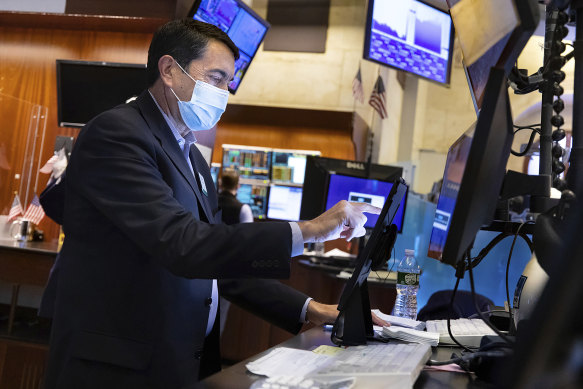ASX set to slip as Wall Street wobbles to start December
By Damian Troise
Stocks fell in uneven trading on Wall Street on Thursday and bond yields pulled back after the government reported that a measure of inflation that’s closely watched by the Federal Reserve eased in October.
The S&P 500 closed 0.1 per cent lower while the Dow Jones fell by 0.5 per cent. The tech-heavy Nasdaq added 0.1 per cent. The Australian sharemarket is set to slip, with futures at 7.59am AEDT pointing to a fall of 15 points, or 0.2 per cent, at the open. The ASX hit a seven-month high on Thursday after Jerome Powell sparked a rally on world markets.

Salesforce slumped 8.3 per cent as Bret Taylor said he would resign as co-CEO of the customer-management software developer.
Major indexes are coming off of their second-straight month of gains.
Yields on both short-term and long-term bonds fell. The yield on the 10-year Treasury, which influences mortgage rates, edged lower to 3.56 per cent from 3.61 per cent late on Wednesday.
Investors are reviewing the latest update on inflation. A measure of inflation that is closely monitored by the Fed eased in October. Wall Street has been closely watching any updates about inflation to get a better sense of whether the Fed will tone down its aggressive interest rate increases.
The central bank has been deliberately slowing the economy in order to tame stubbornly hot inflation. Prices have been falling, but still remain historically high.
Fed Chair Powell said on Wednesday in the US that the central bank could begin moderating its pace of rate hikes as soon as December, when its policymaking committee will hold its next meeting. The Fed, though, has been very clear about its intent to continue raising interest rates until it is sure that inflation is cooling.
The Fed has raised its benchmark rate six times since March, driving it to a range of 3.75 per cent to 4 per cent, the highest in 15 years. Wall Street expects the benchmark rate to reach a peak range of 5 per cent to 5.25 per cent by the middle of 2023.
A big concern for Wall Street has been whether the Fed can tame rates without sending the economy into a recession as it hits the brakes on economic growth. Businesses are seeing demand fall for a wide range of goods as inflation squeezes wallets and analysts generally expect the US to dip into a recession, even if it is mild and short, at some point in 2023.
“What turns mild recessions into deep economic scarring is the buildup of excess, and we don’t have a bubble this time,” said Katie Nixon, chief investment officer for Northern Trust Wealth Management.
Inflation will continue to be the main focus for Wall Street, and “on that score, things seem to be coming off the boil,” she said.
The latest government data on inflation comes amid several reports from the employment sector showing that the labor market is starting to soften. The strong labor market has been good for the economy, but has made it more difficult for the Fed to fight inflation as wages grow. The closely watched monthly report on the job market will be released on Friday.
Investors are also getting more data this week on inflation’s impact over the broader economy. Activity in the manufacturing sector contracted in November for the first time since May 2020, according to the Institute for Supply Management. The report also shows that prices are falling.
“All signs point to a deceleration of inflation in everything except wages,” Nixon said. “That is sort of the last man standing.”
The Market Recap newsletter is a wrap of the day’s trading. Get it each weekday afternoon.
Most Viewed in Business
Source: Thanks smh.com